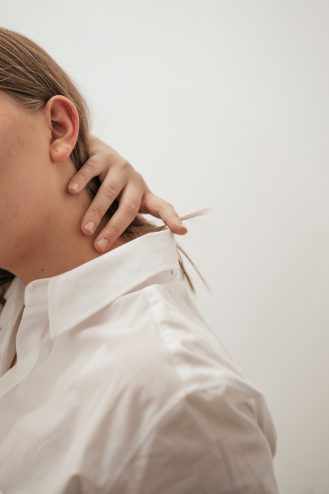If you have pain in the lower part of your neck, it is very likely that this is due to an injury degenerative developing between the fifth and sixth cervical vertebra, called the C5-C6 degenerative disc disease.
What is C5-C6 degenerative disc disease ? How does it manifest? and what steps can be taken to slow down this pathological process? Answers in this article.
Cervical Spine Anatomy
The spine or cervical spine corresponds to the bony portion of the spine forming the neck. It is made up of 7 vertebrae united by intervertebral discs and very powerful ligaments.
The cervical spine is divided into two levels. We distinguish an upper part named cervical spine upper and a lower part corresponding to the lower cervical spine.
The upper floor has two vertebrae C1 and C2, also called theatlas and axis.
The anatomy of these vertebrae is very particular. The atlas, which serves as a pivot whose morphology allows movement from front to back of the head. The axis located under the atlas is used for rotation. A bony process called a tooth articulates with the atlas, allowing the head to turn from side to side.
Pathologies affecting this level are infrequent. However, osteoarthritis developing between these two vertebrae can lead to a pain syndrome.
The lower floor includes 5 vertebrae named from C3 to C7.
What is C5-C6 degenerative disc disease?
La disc disease is a disease that affects the intervertebral disc, the disc located between two vertebrae of the spine. It most often manifests itself in the form of disc disease degenerative (or disc degeneration) which is a process due to theOsteoarthritis.
Spinal disc wear and tear is a natural phenomenon associated with aging, but can be accelerated by lifestyle factors (e.g. repeated bad postures of the neck) leading to dehydration of the discs, which thin and wear out much faster.
This process of deterioration of the discs induces friction between the vertebrae causing their deformation and the appearance of the different symptoms characterizing this discopathy.
La disc disease can affect all intervertebral discs. However, it is rare for it to appear in the thoracic (dorsal) spine. Usually, this condition manifests more in the cervical and lumbar region due to the high stress placed on these anatomical regions.
La C5-C6 degenerative disc disease touches the disc located between the C5 and C6 cervical vertebrae, located more precisely at the base of the neck. It is a progressive deterioration process mainly due to osteoarthritis and aging.
Other causes can also trigger or accelerate its development.
Causes of C5-C6 Degenerative Disc Disease
La degenerative disc disease is the prerogative of people aged 40 and over.
The intervertebral discs undergo progressive aging by degradation of the quality of the cartilage, the main material giving elasticity and flexibility to the intervertebral disc. The latter stiffens and thins progressively until it cracks, thus causing a total flattening, responsible for discopathy.
In addition, there are many causes of disc disease, including:
- The profession
This concerns professions that require the back, such as carrying heavy loads, professions requiring sustained and repeated effort.
- Genetic
There is a genetic predisposition. That is to say, if one of the members of a family is affected, the other members will be predisposed.
- Overweight
Excess weight can increase stress on the joints and cause deformities in the cervical region.
- Physical inactivity
A sedentary lifestyle accelerates disc degeneration because the stresses are applied only to a small portion of the disc instead of its entire surface, therefore the discs wear out more quickly.
- Smoking
Tobacco is the main cause of poor blood circulation in the tissues. This causes dehydration of the gelatinous nucleus as well as the cartilage of the discs.
This dehydration limits, in fact, the ability of the core to absorb shocks as well as the flexibility of the cartilage.
Symptoms of degenerative disc disease
The master symptom in the case of cervical discopathy C5-C6 is neck pain.
Indeed, the dysfunction of the discs resulting from the friction between the vertebrae, can cause deep pain in the neck, the intensity of which depends on the importance of the degeneration.
It should be noted that the symptomatology varies from patient to patient, as each affected disc reacts differently.
In addition to neck pain and throughout the neck, pain can also be observed in certain areas, namely the shoulders and arms.
In addition, the patient may show symptoms evoking a neurological attack, such as tingling, numbness, unrest sensory or alternatively headache (headaches) persistent.
Diagnostic
The diagnosis will be evoked following a meticulous interrogation on the symptoms and the personal antecedents of the patient as well as a complete clinical examination.
Then, it will be confirmed by carrying out additional examinations, based on x-ray pictures, essentially a IRM (magnetic resonance imaging) and/or a myelography (examination aimed at detecting pathologies of the spinal cord).
This series of examinations makes it possible to evaluate the degree of degeneration of the cervical intervertebral discs, the causes of the discopathy and, possibly, the diagnosis of a cervico brachial neuralgia which corresponds to a pain of neurological origin, starting from the neck and describing a precise painful path in the arm and the forearm, to end at the level of one or more fingers of the hand.
These same examinations could show a pinch of the C5-C6 intervertebral space or even a disc protrusion C5-C6.
What treatment to offer in case of C5-C6 degenerative disc disease?
Current conventional therapies have shown no effect on the progression of this pathology. This can be explained by the degenerative, and therefore irreversible, nature of the disc damage.
Treatment will therefore focus on relieving symptoms and improving patients' quality of life.
Medication
Prescription and over-the-counter medications are used to help relieve spinal and nerve pain related to C5-C6 disc disease.
The most common drugs are analgesics (or analgesics) such as opioids, NSAIDs/AIS (nonsteroidal or steroidal anti-inflammatory drugs).
Some healthcare professionals may also prescribe calcium and vitamin supplementation to strengthen bones.
Physiotherapy
This approach is a valuable asset in relieving the symptoms associated with this disease. Indeed, active movement therapy is a first-line treatment associated with a mild analgesic.
The exercises proposed by the physiotherapist will improve blood flow in this area of the spine, strengthening the back and neck muscles which will allow flexibility and mobility of the spine to be maintained.
acupressure mat
THEacupressure is a non-intrusive method of care that aims to stimulate a set of nerve points in the back, for therapeutic purposes.
This form of punctual and natural stimulation from traditional Chinese medicine, allows the body to benefit from analgesic effects as well as a good dynamization of the blood flow.
acupressure mat, sometimes named acupuncture mat or lotus flower mat is made of cotton or other similar materials, containing plastic acupuncture points which stimulate specific areas of the body to relieve pain by stimulating the secretion of endorphin (happiness hormone).
If you are interested in an acupressure mat, check the following article first.
Adopt a better lifestyle
It is true that degenerative disc disease is a disease that is difficult to modify from an anatomical point of view. Its prevention is therefore preferable. To do this, it is recommended to exercise regularly and to lead a healthy lifestyle.
This will improve blood circulation and provide more effective support for your back muscles. In some cases, overweight people need to diet, especially if there is a link between weight and symptoms. The goal would then be to reduce stress on the lower back vertebrae.
It is strongly recommended to maintain a good posture, more specifically to avoid prolonged static postures. Exceptionally, the use of a cushion or cervical hammock temporarily can relieve pain by reducing tension, if ever the symptoms are intolerable or when performing a risky physical activity.
Can surgical treatment be considered?
La laminectomies, an operation aimed at performing an arthrodesis surgically, can be considered if the pain is unbearable and/or if the drug treatment fails.
La surgery is done to relieve pain, but it should be understood that pain will not go away overnight.
The risk of paralysis after spinal surgery is not zero. This is one of the main reasons to respect the recovery period, even if the final results of the procedure appear only after months of rehabilitation.
Either way, adopting a lifestyle that limits the risk of C5-C6 degenerative disc disease is the best option.
My name is Sidali. I am a general practitioner and Web Editor. As a healthcare professional, my mission is to contribute to the relief of my patients' ailments. Being also passionate about writing, I have the pleasure of sharing my solid medical knowledge with the greatest number of readers, by writing popular articles that are very pleasant to read.


